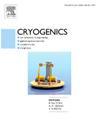Operation of helium sub-atmospheric multistage cryogenic centrifugal compressor trains: Part 1 – Steady state modeling and speed ratio selection
IF 2.1
3区 工程技术
Q3 PHYSICS, APPLIED
引用次数: 0
Abstract
Helium cryogenic systems which can provide cooling below the normal boiling point of helium (approximately 4.2 K) are often required by superconducting radio-frequency niobium resonators utilized in modern high-energy particle accelerators. Achieving temperatures below 4.2 K generally involves operating a cryogenic vessel with liquid helium under sub-atmospheric conditions, thereby lowering the saturation pressure and corresponding saturation temperature. Over the last several decades, multi-stage cryogenic centrifugal compressor trains (CC’s) have been operated efficiently and reliably within large-scale cryogenic systems to continuously evacuate helium vapor generated by a device within the vessel, maintaining sub-atmospheric conditions in the vessel while pressurizing the return vapor to above atmospheric conditions. Traditionally, these CC systems have been operated using empirically derived control philosophies and insight gathered from previous operational experience. Recent efforts at the Facility for Rare Isotope Beams (FRIB) have been aimed at the development of a theoretical basis to characterize the operation of multi-stage cryogenic centrifugal compressor train and utilizing predictive model results to generate control parameters. The objective of this research was identifying operational points which adequately balance cryogenic system efficiency, stability, and overall ease of operation. This manuscript provides an overview of the predictive model development, characterization of the FRIB cryogenic centrifugal compressors and implementation of the predicted performance results during steady-state system operation.
氦亚大气压多级低温离心压缩机组的运行。第1部分-稳态建模和速比选择
氦低温系统可以提供低于氦的正常沸点(约4.2 K)的冷却,通常需要用于现代高能粒子加速器的超导射频铌谐振器。要达到低于4.2 K的温度,通常需要在亚大气条件下使用液氦的低温容器,从而降低饱和压力和相应的饱和温度。在过去的几十年里,多级低温离心压缩机组(CC’s)在大型低温系统中高效可靠地运行,连续排出容器内装置产生的氦蒸汽,保持容器内的亚大气状态,同时将返回的蒸汽加压到高于大气条件。传统上,这些CC系统使用经验推导的控制理念和从以前的操作经验中收集的见解来操作。最近,稀有同位素束流设施(FRIB)的工作目标是发展一个理论基础,以表征多级低温离心压缩机组的运行,并利用预测模型结果来生成控制参数。本研究的目的是确定操作点,以充分平衡低温系统的效率,稳定性和整体操作的便利性。本文概述了预测模型的发展、FRIB低温离心压缩机的特性以及在稳态系统运行期间预测性能结果的实现。
本文章由计算机程序翻译,如有差异,请以英文原文为准。
求助全文
约1分钟内获得全文
求助全文
来源期刊

Cryogenics
物理-热力学
CiteScore
3.80
自引率
9.50%
发文量
0
审稿时长
2.1 months
期刊介绍:
Cryogenics is the world''s leading journal focusing on all aspects of cryoengineering and cryogenics. Papers published in Cryogenics cover a wide variety of subjects in low temperature engineering and research. Among the areas covered are:
- Applications of superconductivity: magnets, electronics, devices
- Superconductors and their properties
- Properties of materials: metals, alloys, composites, polymers, insulations
- New applications of cryogenic technology to processes, devices, machinery
- Refrigeration and liquefaction technology
- Thermodynamics
- Fluid properties and fluid mechanics
- Heat transfer
- Thermometry and measurement science
- Cryogenics in medicine
- Cryoelectronics
 求助内容:
求助内容: 应助结果提醒方式:
应助结果提醒方式:


